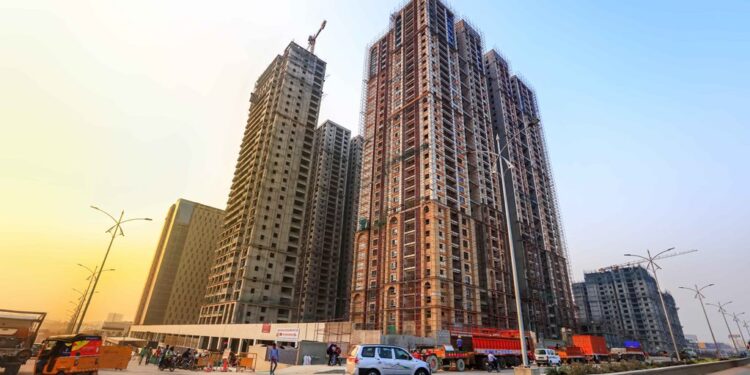NRIs scout for branded real estate players in India but defaults, delays and dodgy practices continue to be the bane of the property market in the country of their origin
BY VISHAL DUGGAL
With lakhs of units locked in stalled real estate projects in India and developers’ inability to deliver at all or on time, expatriate Indians are in the grip of a long, persistent shadow of doubt. Worse, poor enforcement of fair practices, coupled with lack of governance and inept and inefficient functioning of bureaucracy and the regulatory regime, has failed to inspire their confidence regarding transparency, quality and timely delivery of projects. In such a gloomy scenario, listed realty companies are the best bet for investment for NRI investors.
Significantly, as per property advisory group ANAROCK, the top listed developers sold as much as 21.23 mn sq ft of area in the first three quarters of financial year 2021. Overall, their sales share increased to 22%, up from 6% in FY2017. Even non- listed but leading, reputed developers ramped up their share from 11% in FY2017 to 18% in the first nine months of FY21. Among the listed players, Godrej Properties sold the maximum in terms of area (approximately 6.64 mn sq ft) in this period, followed by Bengaluru-based Prestige Estates with approximately 5.04 mn sq ft.
Continuing to reap dividends from the post-pandemic surge in demand for branded homes, the top stock exchange-listed developers raked in ₹14,883 crore of revenue bookings in H1 FY22 – a sharp uptick from ₹9,483 crore in the same period of the previous fiscal.
Driven by home buyers’ increasing preference for branded homes, the listed developers once again out-performed the market. Notably, these players have also reconfigured their supply pipeline to deliver projects in the affordable, mid-segment and premium segments. The ongoing low interest rate regime and home buyers’ desire to avoid construction related risks also played a role.
“Less than a decade ago, a largely speculator-driven housing market saw unnatural demand chasing the wrong kind of supply,” says Anuj Puri, chairman, ANAROCK Group. “Today, these players are unleashing right-priced, right-sized supply clearly aimed at organic end-user demand. This is the result of intensive market research before pressing the ‘commit’ button and is one of the most notable features of the reinvented Indian housing market.”
Evidently, property buyers now prefer to entrust their investment with organised, reputed and branded players. This is more so the case with NRIs who prefer to buy properties of major real estate brands that have a reputation for transparency, credibility, compliance with laws, rational pricing and reliable after-sales service. The growing preference for branded properties is all too understandable but, on a larger level, why should relying on only branded players be the sole method of ensuring safety and profitability in realty investment? Isn’t this further evidence of the collapse of governance and the regulatory set-up governing real estate in India?
Further, one cannot rule out that some issues may arise post-purchase of property from even branded real estate companies too. But there is no ‘real’ avenue of holistic, meaningful grievance redressal for a property purchaser despite the multiplicity of authorities that have jurisdiction in real estate cases in India: the Consumer Protection Act, 1986, the Real Estate (Regulation and Development) Act, 2016, and the Insolvency and Bankruptcy Code (IBC), 2016. This is borne out by a close look at the efficacy of the grievance redressal statutory regime in the country.
CONSUMER COURTS
Though consumer forums – District Consumer Disputes Redressal Forums, State Consumer Disputes Redressal Commissions and the National Consumer Disputes Redressal Commission (NCDRC) – have the power to execute their own orders they are plagued by the gargantuan backlog of pending cases which causes painful delay in pronouncement of judgments, resulting in an average of five to six years for adjudication of a dispute. Worse, defaulting builders can prolong the trauma of home buyers by moving higher fora or even the Supreme Court against the verdict of the highest consumer court, the NCDRC.
RERA
The Real Estate Regulatory Authority (RERA) was set up to usher in transparency and fair practices in the real estate sector but it has been a big let-down for complainants as, though it does pass orders in a relatively short time, it cannot ensure grant of actual relief to complainants, whether in the form of delivery of their property or refund of their lifetime savings. Builders, by and large, choose to overlook the decree of possession or issuance of a recovery certificate (RC) or resort to dragging buyers to higher judicial fora.
NCLT
Property buyers can file a case of insolvency against a developer by approaching the National Company Law Tribunal (NCLT) under the Insolvency and Bankruptcy Code (IBC) when they find that the developer’s financial position is fragile and he will not be able to complete the project and refund their invested money along with interest.
Once NCLT admits the insolvency application, it initiates the corporate insolvency resolution process (CIRP) to resolve issues related to defaults. But this involves liquidating the assets of a project/ developer which is a highly complex and lengthy route that leaves the consumer mentally and financially drained. Further, the NCLT option has been rendered beyond the reach of single/few buyers by way of an amendment to the IBC that requires not less than 100 or 10% allottees of a particular project to make a joint application to NCLT for initiation of insolvency against a developer.
Thus, these are the harsh realities of various legal remedies available to both resident and non-resident Indians. Until the inherent lacunae and inadequacies in the enforcement of these options are adequately addressed and removed, the presence of branded players in the real estate sector will provide little succour to consumers.








